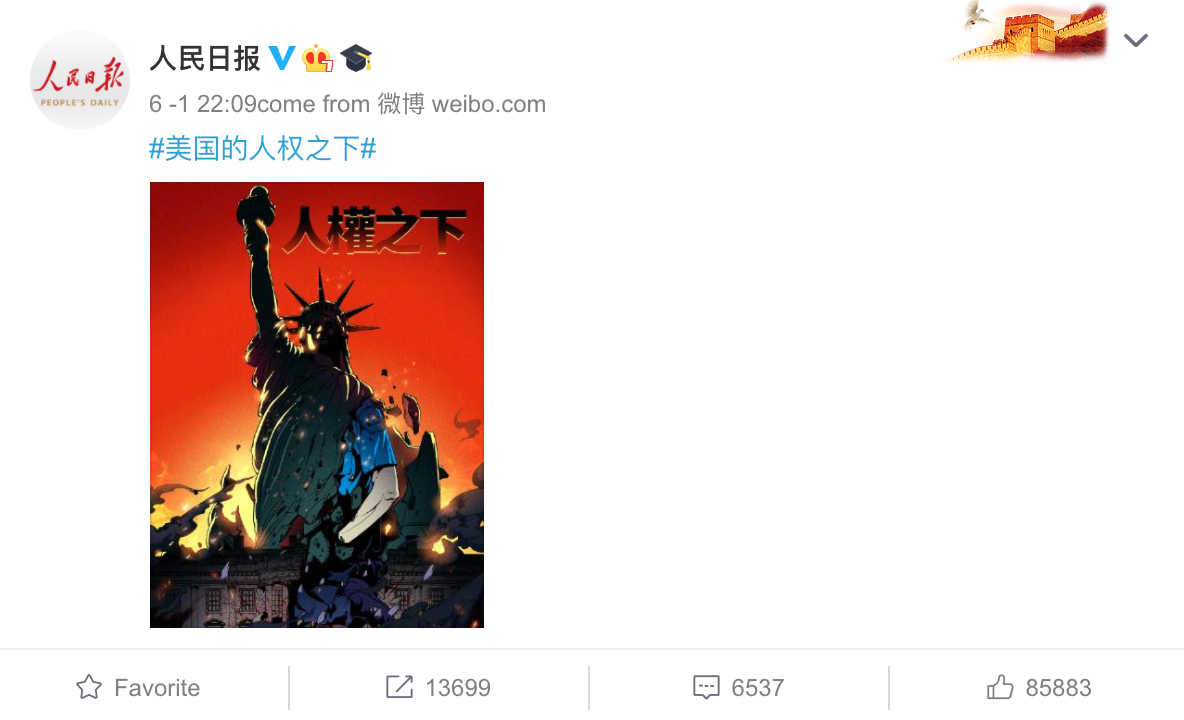Protests have erupted across more than 580 cities in the United States, after the killing of George Floyd in the hands of police on May 25. Viral videos of the 46-year-old Black man's final moments – his neck pinned to the ground by a cop's knee despite consistent pleas that he couldn't breathe – sparked parallel protests in other parts of the world, including the United Kingdom, Canada, and Italy.
Photos of the George Floyd protests in the U.S. show massive crowds and powerful signs with other areas erupting into violence and property damage. Together, they paint a moving picture of anger that has been bubbling beneath the surface of American society, a call for the dismantling of systemic racism against Black people.
While people around the world show their solidarity with victims of police brutality and racial discrimination, officials and state media in China have a starkly different reaction.
On May 30, China’s state-run newspaper the Global Times ran an article titled, “Watch out! 'Beautiful sight' in HK is spreading across the U.S.,” which references House Speaker Nancy Pelosi calling the demonstrations in Hong Kong “a beautiful sight to behold” last year.
“Now, the ‘beautiful sight’ is extending from Hong Kong to over a dozen U.S. states,” reads the piece by Hu Xijin, editor-in-chief of the Global Times. “U.S. politicians now can enjoy this sight from their own windows.”
“Washington must have failed to anticipate that retribution could come that fast,” he continues. “Let's wait and see which country will encounter more chaos.”
Chinese Foreign Ministry spokesperson Hua Chunying also appeared to revel in the chaos that has engulfed the U.S., using Twitter to serve playground insults. In a tweet, he referenced Floyd's final words, as a response to a criticism against Beijing's stronghold in Hong Kong. Other Chinese officials have taken on similar tactics to mock their American counterparts.
Meanwhile, a picture posted by Chinese state mouthpiece People’s Daily on June 1 shows a dystopian drawing of the Statue of Liberty engulfed in flames. The overlaid text reads: “Under the guise of human rights."

The post was met with smug comments from Chinese netizens. “What a beautiful sight,” reads one comment.

“The sweet smell of freedom,” said another.

“Freedom like this is rather perplexing,” reads one comment to a video documenting the arrest of CNN’s reporters covering the protest.

“Here’s a joke: American press freedom,” reads another comment.

Yet some showed their disapproval of the photo, expressing sympathy towards the plight of American demonstrators.
“I can’t believe this came from People’s Daily!” said one Weibo user, referring to the drawing. “Not only is there no sympathy and support for marginalised groups, you’re even mocking them publicly.”

Opinions like that one are scarce, however, as they have largely been drowned out by vast numbers of gloating netizens. As of writing, the hashtag “US riots” has almost 2.2 billion views on Weibo.
According to scholars, the caustic commentary from the Chinese government seems to be a defining element of Xi’s administration.
“China's general approach to commenting on foreign affairs has certainly shifted since Xi Jinping assumed Chairmanship of the [Chinese Communist Party],” Dr. Michael Clarke, Associate Professor of the Australian National University’s National Security College, told VICE.
“Prior to that, China generally pursued a much more cautious posture on official or semi-official commentary on developments in other states.”
Mike Zi Yang, a senior analyst at Singapore’s S. Rajaratnam School of International Studies shares the same sentiment.
“The older generation such as [Chinese Foreign Minister] Wang Yi are a bit more careful [about] commenting on other countries’s internal affairs, while the younger generation, represented by Zhao Lijian, are more outspoken and ‘wolf-warrior’ like,” he said.
The “wolf warriors” are a new group of officials who are not afraid of unleashing their wrath against Beijing’s critics online, most notably through Twitter.
“Now the wolf warriors have the upper hand, we are seeing the Chinese becoming much more outspoken about issues in other countries,” said Yang.
Some are also jumping on the chance to bring the Hong Kong protests into the conversation.
On May 31, Hu tweeted an unsubstantiated theory that the protests in the U.S. were incited by “vicious HK rioters.”
“In a way, it’s revenge for [the Trump administration’s] frequent criticisms [of] Beijing,” said Yang. “If troops are used, the U.S. government will have even less legitimacy to comment on how China handles [Hong Kong].”
However, according to Dr. Lee Jonghyuk, Assistant Professor of the China Programme at Singapore’s S. Rajaratnam School of International Studies, these passive aggressive digs at the George Floyd protests may reveal surprisingly little about China’s true intentions. Scathing as they may be, Lee thinks that they “actually have no substantial meaning” in Chinese foreign policy.
Mid-ranking officials are the ones responsible for foreign communications, while top leadership such as Xi and other Politburo Standing Committee members do not engage with these narratives, he said.
“The significance of [China’s responses] is marginal because they are not designed by the top decision-makers,” Lee said.
Find Koh Ewe on Instagram.
from VICE https://ift.tt/2Y6rHLt
via cheap web hosting
No comments:
Post a Comment